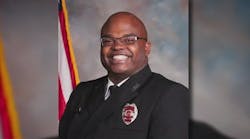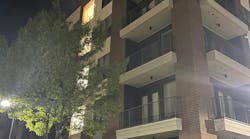Sometimes the IC would add a bit to his instructions to a unit about special conditions, but often nothing was passed and the unit officer was left to find out for himself about a condition, which was known to command. Conversely the unit officer might find a condition but would hesitate to pass it along for fear of a patronizing "WE know all about that."
All units on the fire ground should be on the same page. Radio makes it possible.
Builders take advantage of steep or rolling terrain to provide floors not visible from the front of the building. Typically, a lot falls away from the street level A walk- in basement accessible from the rear provides another daylight floor. On steeper lots two or even three stories may be below grade.
Firefighters have died because this situation was known to those in the rear but not to command out front. In a District of Columbia fire, units in the rear saw combustible tile burning on the ceiling and falling to the floor. The IC, thinking they were looking at the first floor, denied permission to start water because firefighters were on the first floor. When the basement flashed over, a ball of fire rolled up the stairs and two firefighters died and another was badly burned.
There is a simple solution. Such a building should be described as a two-slash-three building (2/3). This will tell everybody that the building is two stories in the front and three stories in the rear.
Our home in Scientists Cliffs backs up on a hill. It would be described as a two-slash-one (2/1). In hilly country there are many two /four buildings. One such was the scene of a three-firefighter fatality.
The terrain can be used to beat the code. In many cases the code limits the height of combustible or ordinary construction to limit the amount of fire which it can provide. The height is measured from the curb in front of the building. When the lot falls away additional stories can be provided at the rear.
A most egregious example is in New York City. Yankee Stadium was built in the flat flood plain of the Harlem River. Just to the west, the terrain rises steeply to Morris Heights. Apartment houses were built. The code allowed six stories at the front on the street on top of the rise. Three or four stories were built at the rear below the street grade, thus producing a nine or ten story ordinary construction apartment house.
In the apartment house boom of the late twenties and early thirties in the Bronx and Upper Manhattan, there were two rival groups involved in the crafts. One group would set fire to the other group's building just when it was fully wood lathed, often in broad daylight. The building would be fully involved on arrival.
The most spectacular was the group of buildings just west of Yankee Stadium, a nighttime fire, fully involved on arrival. I ran to a number of the daytime fires. First lines were master streams to cover exposures.
Many one-story commercial buildings are two stories in the rear. While writing this I had a phone call from an old friend, Deputy Chief Dave Mager, Boston FD, who told me that many Boston brownstones have two basement levels. The upper is a living basement. The lower is the storage and utility space.
This is a simple, easily understood NO COST system which can save lives.
If your fire department adopts it, please email me.
If the powers that be refuse to adopt it, please email me their reasoning so that I might reformulate my presentation.
One objection was, "our IC's make a walk around to be aware of the building". Fine. But why won't you let them tell everybody at once.
Some objections to any change are just evidence of the NIH syndrome, "Not Invented Here". Why not humor a poor old man who is looking at the grim reaper. Nothing specific thank you. Just a fact of life. It took years to get almost everybody on board on trusses. This simple item should not take any time at all.
I think this is important and I do not wish to present it again after a deadly fire.
THE BUILDING IS YOUR ENEMY KNOW YOUR ENEMY





